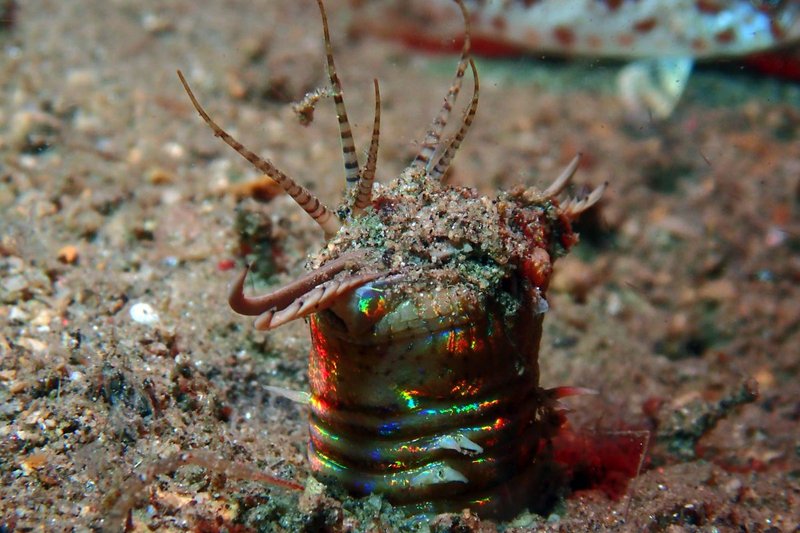
Understanding Bobbit Worms
Bobbit worms, or *Eunice aphroditois*, are marine polychaete worms that can grow quite long—up to ten feet in some cases! They’re named after the infamous story of John Wayne Bobbitt because of their fierce hunting technique. These worms can remain hidden in the sand, only revealing their impressive jaws when prey comes too close. It’s like having a sneaky predator hiding in your ocean floor, ready to pounce on anything that comes within reach.
Their vibrant colors can range from green to red and even blue, which makes them visually stunning additions to a tank. But here’s the thing: while they might look beautiful, keeping them in a species-specific display comes with challenges. Understanding their natural habitat and behavior is key to providing a suitable environment.
The Ideal Habitat for Bobbit Worms
Bobbit worms thrive in sandy substrates and prefer slightly dim environments, mimicking their natural ocean habitats. They’re typically found in coral reefs and sandy bottoms, often buried to avoid predators. To create a great home for them, you’ll want to:
- Provide a deep layer of fine substrate where they can bury themselves.
- Ensure there are hiding spots like rocks or coral for them to feel safe.
- Maintain stable water parameters, especially salinity and temperature.
While it’s tempting to set up a colorful display with various fish, remember that Bobbit worms won’t coexist peacefully with every species. They can be a threat to smaller fish and invertebrates, so you need to choose tank mates wisely.
Can Bobbit Worms Live with Other Species?
You might be wondering if Bobbit worms can share a tank with other marine life. The short answer is: it depends. Bobbit worms can be territorial and aggressive, particularly when it comes to smaller fish or critters. If they feel threatened or hungry, they might see fish as a meal.
If you’re considering keeping Bobbit worms, you should think about potential tank mates carefully. Some safer options include larger fish that won’t fit in their jaws, like:
- Large tangs
- Groupers
- Angelfish
In contrast, small fish, shrimp, or delicate corals could quickly become victims of a Bobbit worm’s predatory nature.
Stress Factors in the Aquarium
Bobbit worms can be sensitive to tank conditions. Issues like poor water quality, dramatic temperature changes, or aggressive tank mates can lead to stress. If they’re stressed, they might start behaving unpredictably, which can affect the entire tank setup. Here are some factors that can contribute to stress:
- Poor filtration and high levels of ammonia or nitrites.
- Inconsistent water parameters (like pH or temperature).
- Overcrowded or overly aggressive tank mates.
For a healthy Bobbit worm, ensuring a stable environment is essential. Regular water changes and monitoring tank conditions can help keep stress levels down.
Feeding Bobbit Worms: What You Need to Know
Feeding Bobbit worms is another important aspect of care. They’re carnivorous and need a diet that reflects their natural feeding habits. In the wild, they catch small fish and crustaceans, so you should aim to provide similar food in your home aquarium. Here are some feeding tips:
- Offer high-quality frozen or live food like brine shrimp, small fish, or worms.
- Make sure to feed them at night when they’re most active.
- Be cautious not to overfeed, as leftover food can foul the tank.
The right feeding routine not only keeps your Bobbit worms healthy but also minimizes the chances of them turning predatory on any other tank residents.
Signs of a Healthy Bobbit Worm
When you have Bobbit worms, it’s crucial to keep an eye on their health. Healthy Bobbit worms typically exhibit certain behaviors, such as actively hunting or extending their “feelers” out of the substrate. Some signs of a healthy worm include:
- Bright colors and robust body structure.
- Active movements and appropriate hunting behavior.
- They’ve established a stable burrow without signs of stress.
If you notice any changes in these behaviors, it might be a sign that something is off in the tank.
Setting Up a Species-Specific Display with Bobbit Worms
So, you’re convinced that Bobbit worms can be a beautiful addition to your aquarium, and you want to keep a species-specific display. What does that look like? First, it’s essential to consider the tank size and design. A larger tank, ideally over 50 gallons, allows more space for these worms to thrive without feeling confined.
Your setup should focus on creating a natural environment. Include plenty of hiding spots and a deep, sandy substrate. Also, consider the following elements:
- Robust filtration to maintain water quality since Bobbit worms can produce waste.
- Dim lighting, as they prefer darker habitats.
- Appropriate tank mates that won’t disturb them.
Creating the right environment is key to keeping Bobbit worms healthy and allowing them to thrive in a species-specific display.
Alternatives for a Diverse Aquarium
If you’re still on the fence about introducing Bobbit worms to your tank, consider alternatives that might fit your desire for a unique marine display without the challenges. Some options include:
- Coral setups that focus on reef-safe fish and invertebrates.
- Using larger, non-aggressive worms that can coexist with other marine life.
- Creating a community tank with resilient species that can handle potential threats.
With these alternatives, you can still enjoy a beautiful aquarium without the complications that come with keeping Bobbit worms.
Keeping **Bobbit worms** in species-specific displays can be an exhilarating adventure, but it also requires careful planning and consideration. While they add stunning visual interest to your aquarium, understanding their habits, habitat needs, and potential compatibility challenges is crucial.
By providing a suitable environment and being mindful of their behavior, you could enjoy the unique experience of housing these fascinating creatures. Whether you decide to go for Bobbit worms or opt for alternatives, the goal is to create a vibrant, thriving aquarium that brings you joy. So, dive into this underwater world with confidence and curiosity!

